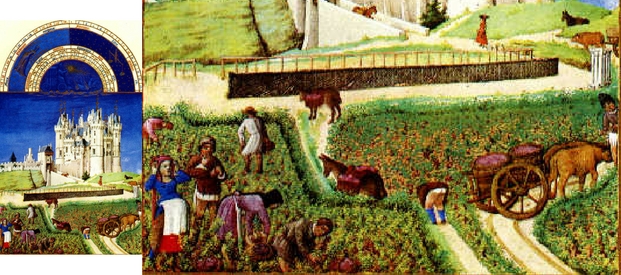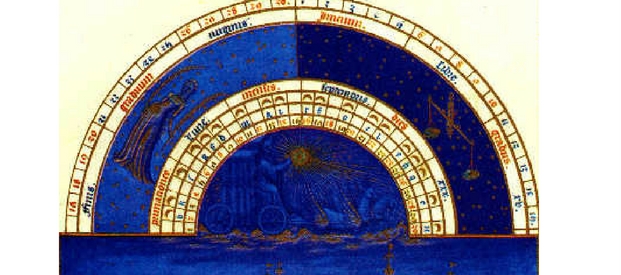September’s Grape Harvest – The Calendar in Medieval Art
Harvest time is upon us as summer draws to an end. We take a look at the beautiful medieval painting of September’s grape harvest in the illustrated manuscript, the Très Riches Heures.
Popular in the Middle Ages, a Book of Hours is a type of book which includes prayers, psalms and texts, as well as a calendar marked with church feasts and saints’ days. Wealthy people could commission their own Book of Hours, which would often be sumptuously illustrated, perhaps including their own portrait. Even more modest households could own a much simpler Book of Hours with decorated capital letters at the start of each prayer; and towards the end of the 15th century, advances in printing practices made these books even more affordable.
September’s grape harvest

This beautiful picture is from a Book of Hours known as the Très Riches Heures, commissioned in the 15th century by Jean, Duc de Berry, brother of King Charles II of France. It is one of twelve miniatures in the book’s calendar and illustrates the September grape harvest. In the foreground a pregnant woman in a red and white apron stretches her back, while other peasants pick and taste the grapes. Two oxen pull a cart loaded with vats full of grapes, while mules with panniers wait nearby. Behind this rural scene stands the magnificent Château de Saumur with fairy tale turrets, chimneys and weathervanes; and between the two, surrounded by a rough fence, is a tilting ground for tournaments.
Feasting in January, Chopping wood in February
Other months are illustrated with similarly detailed scenes. For January, the artist shows a New Year feast at which Jean, Duc de Berry, dressed in a brilliant blue robe, offers gifts to his household. In February’s snowy landscape, sheep huddle in the byre and three peasants warm themselves by the fire while another chops wood and one heads off to market.
An outstanding work of art
Each miniature in the Très Riches Heures is full of detail, giving an insight into the realities of medieval life, both in the countryside and at court. Gold leaf and rare pigments such as vert de flambe, made from crushed wild irises, and azur d’outremer, a shade of blue made from costly Oriental lapis-lazuli, give the pictures an intensity of colour as in stained glass windows.
At the time of its commission it was unusual for a Book of Hours to include such lavish full page landscapes as part of the calendar, and it is these and the unique subjects of other pictures, along with the harmony of composition and delicate brushwork, which make this an outstanding masterpiece.
The artists
Three artists, Paul, Jean and Herman Limbourg created this magnificent manuscript. The brothers lived as part of the Duc de Berry’s household and began working on the Très Riches Heures around 1413, under the guidance of master-of-the-workshop Paul. For three years they worked on the many miniatures planned for the book, until abruptly work ceased in 1416 when all three died, probably from plague. Jean, Duc de Berry died later the same year and the work remained unfinished for many years until eventually, towards the end of the century, artist Jean Colombe was commissioned to complete the unfinished paintings. Tastes and fashions had changed in the seventy years since the brothers began the project, and Colombe chose to finish the paintings in his own bolder, more modern style.
The famous September miniature is one of the works created by two artists. It was begun by Paul Limbourg, who painted the sky and château and sketched a plan for the foreground before he died. Seventy years later, Jean Colombe added the grape picking scene and completed this beautiful illustration.
Take guidance from these beautiful works of art and consider calendar advertising to promote your business by using the high quality pictures available on all our pictorial calendars. Images are sourced newly each and every year, offer stunning variety and an insight into many different genres, from scenery or wildlife to transport and themed calendars.










